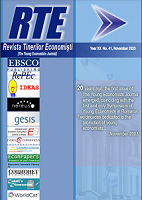EVOLUTION OF THE GINI COEFFICIENT IN CENTRAL AND EASTERN EUROPEAN COUNTRIES
EVOLUTION OF THE GINI COEFFICIENT IN CENTRAL AND EASTERN EUROPEAN COUNTRIES
Author(s): Simona Maria EneSubject(s): Public Finances, Fiscal Politics / Budgeting, Socio-Economic Research
Published by: Editura Universitaria Craiova
Keywords: Gini coefficient; economic inequality; Lorenz curve; fiscal policy; economic indicators;
Summary/Abstract: The Gini coefficient, a key tool in analyzing economic inequality, is widely used in the economic and social fields. This coefficient measures the degree of inequality in the distribution of income or other economic variables, with values ranging from 0 (perfect equality) to 1 (perfect inequality). To calculate the Gini coefficient, procedures such as ranking incomes in ascending order, determining the cumulative proportion of income for each percentage of the population and constructing the Lorenz curve are followed. This indicator makes it possible to compare economic inequality between countries, regions and social groups and to monitor its evolution. This 10-year analysis of the Gini coefficient in 11 countries shows significant variations and upward or downward trends in economic inequality. Most countries in Central and Eastern Europe face significant levels of inequality. The Gini coefficient remains an essential tool for understanding income distribution and formulating more appropriate economic and social policies.
Journal: Revista tinerilor economişti
- Issue Year: 2023
- Issue No: 41
- Page Range: 90-97
- Page Count: 8
- Language: English

